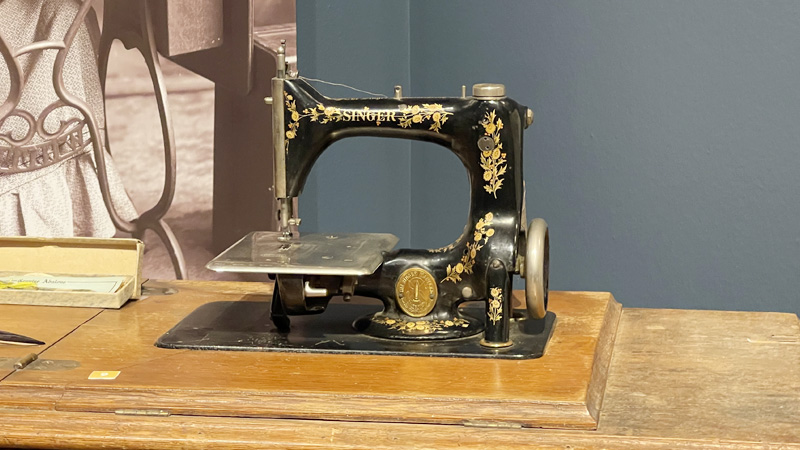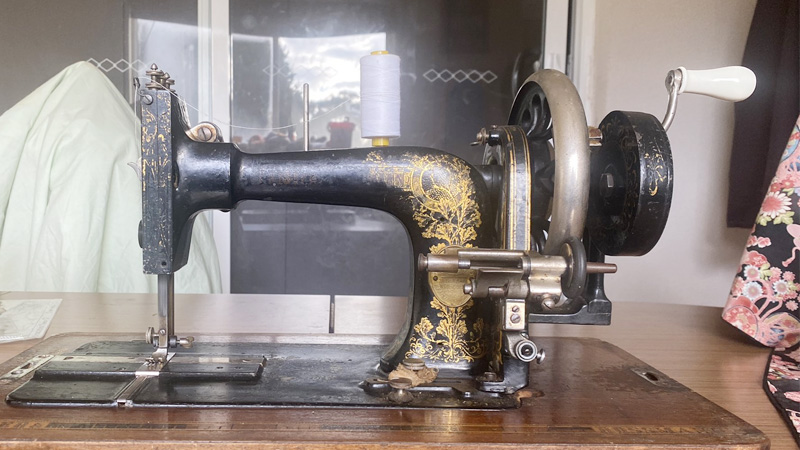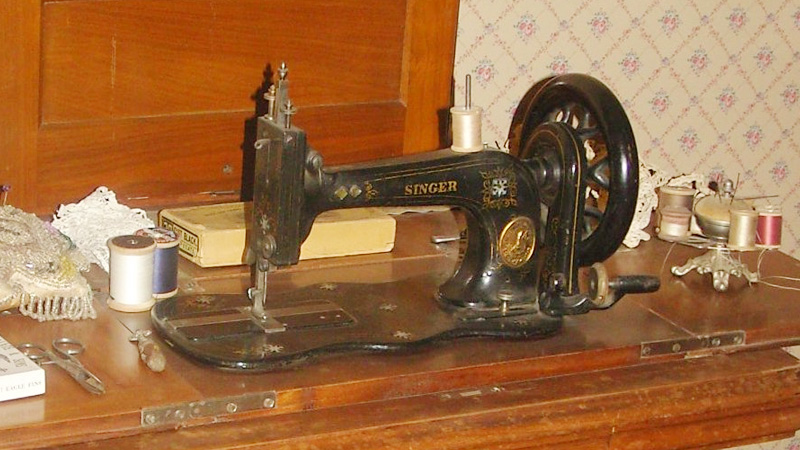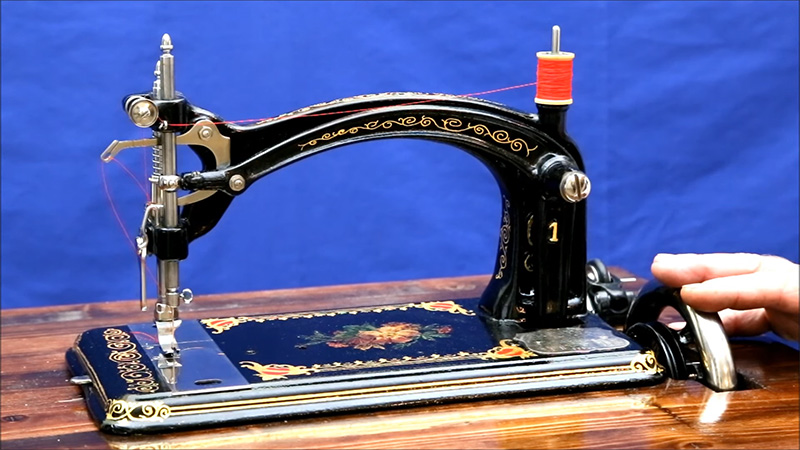In the year 1880, the world was on the cusp of a significant technological and societal transformation. It was an era characterized by the rapid industrialization and innovation of the 19th century.
One of the remarkable advancements during this period was the availability and widespread adoption of machine sewing.
By 1880, the sewing machine had firmly established its place in homes and industries alike, reshaping the way clothing and textiles were produced.
What had once been a laborious and time-consuming task carried out by hand was now made more efficient and accessible through the use of sewing machines.
This pivotal moment in history marked the beginning of a new era in textile manufacturing and sewing, setting the stage for the modern garment industry we know today.

Was Machine Sewing Available in 1880?
Yes, by 1880, machine sewing was widely available and in use. Sewing machines had become a common and integral part of both households and industrial settings by that time.
The invention of the sewing machine, dating back to Elias Howe’s machine in 1846 and subsequent improvements by other inventors like Isaac Singer and the Wheeler & Wilson Company, had already revolutionized the textile and garment industries.
These machines were capable of greatly increasing the speed and efficiency of sewing, making the production of clothing and textiles more accessible and cost-effective.
This availability and adoption of sewing machines in 1880 played a significant role in the growth of the ready-to-wear clothing industry and the transformation of sewing from a laborious manual task to a more mechanized and efficient process.
1880s Sewing Machines -Key Features and Characteristics

In the 1880s, sewing machines had become an integral part of both households and industries. These machines have undergone several developments and improvements since their invention in the mid-19th century.
Here are some key features and characteristics of sewing machines in the 1880s:
Pedal-Operated Machines
Most sewing machines in the 1880s were operated by a foot pedal. Users would press the pedal to power the machine, controlling the stitching speed with their foot.
Lockstitch Technology
Lockstitch sewing machines, which were introduced earlier in the 19th century, remained popular in the 1880s. These machines created a secure and durable stitch by interlocking two threads.
Treadle Machines
Many sewing machines in the 1880s were treadle machines, meaning they were powered by a foot-operated treadle (a lever connected to a wheel) rather than electricity.
Variety of Brands
By the 1880s, several sewing machine manufacturers were producing machines for both domestic and industrial use.
Brands like Singer, Wheeler & Wilson, and Howe had established themselves as leaders in the sewing machine industry.
Portable and Cabinet Machines
Sewing machines were available in various designs. Some were portable and could be placed on a table, while others were built into cabinets, offering storage space and a work surface.
Improved Stitch Quality
Advances in manufacturing techniques led to more consistent and reliable stitching. These machines were capable of producing neater and more precise stitches.
Attachments and Accessories
Sewing machines often come with a range of attachments and accessories, such as different presser feet and specialized needles, allowing users to perform various sewing tasks with ease.
Expanding Home Use
In the 1880s, sewing machines were increasingly found in American homes. They were used for making clothing, mending, and various other sewing projects, significantly reducing the time and effort required for these tasks.
Industrial Applications
Sewing machines were also widely used in industries such as textiles, shoe manufacturing, and upholstery during this period. Their speed and efficiency greatly contributed to the growth of these industries.
History of Sewing Machine

The history of the sewing machine is a story of innovation and technological advancement that revolutionized the textile and garment industries.
Here is a brief overview of the key developments in the history of the sewing machine:
Early Attempts (18th Century)
Before the invention of the sewing machine, sewing was a labor-intensive and time-consuming process done entirely by hand.
Various inventors made early attempts to mechanize sewing, but these machines were often impractical and unreliable.
Elias Howe (1846)
The breakthrough in sewing machine technology came in 1846 when Elias Howe, an American inventor, patented the first practical sewing machine.
Howe’s machine used a lockstitch mechanism, which created a strong and durable stitch. It marked a significant step forward in automating sewing processes.
Isaac Singer (1851)
Isaac Singer, another American inventor, improved upon Howe’s design and introduced the first commercially successful sewing machine in 1851.
Singer’s machine featured several innovations, including a foot pedal for hands-free operation and a continuous feed mechanism.
Wheeler & Wilson (1851)
At the same time Singer, Wheeler & Wilson, a company founded by Allen B. Wilson and Nathaniel Wheeler, also developed a successful sewing machine.
Their machine introduced the concept of a rotary hook mechanism, which significantly improved stitching speed and reliability.
Sewing Machine Companies (Late 19th Century)
In the late 19th century, numerous sewing machine companies emerged, each offering its own variations and improvements to sewing machine technology. This period saw the proliferation of sewing machines in homes and industries.
Electric Sewing Machines (Late 19th to Early 20th Century)
Toward the end of the 19th century and into the early 20th century, electric sewing machines began to replace the earlier manually operated machines. This transition further increased sewing efficiency.
Specialized Machines (20th Century)
In the 20th century, sewing machines continued to evolve and diversify. Specialized machines were developed for various tasks, such as sergers, embroidery machines, and industrial sewing machines for heavy-duty applications.
Computerized Sewing Machines (Late 20th Century)
The late 20th century brought the advent of computerized sewing machines, which allowed for greater precision, automation, and customization of stitches.
Modern Sewing Machines (21st Century)
Today, sewing machines are more advanced than ever, with a wide range of features and capabilities. They are used not only in traditional sewing but also in quilting, crafting, and embroidery.
Was Machine Sewing Available in 1880 in America?

Yes, machine sewing was widely available in America by 1880. By that time, sewing machines had become a common household item and were also widely used in various industries.
The sewing machine had been invented and refined over the preceding decades, making it a practical and accessible tool for both domestic and industrial purposes.
Isaac Singer’s sewing machines, which became popular in the mid-19th century, were especially influential in the United States. Singer’s machines were efficient, reliable, and available for purchase.
Other manufacturers, like Wheeler & Wilson and Grover & Baker, also produced sewing machines that were widely used in American households and businesses.
The availability of sewing machines in 1880 played a crucial role in the growth of the ready-to-wear clothing industry, as well as in making sewing more efficient and accessible for individuals and small-scale garment production.
Who Invented the First Sewing Machine?
The first practical sewing machine was invented by Elias Howe. Howe, an American inventor, received a patent for his sewing machine on September 10, 1846.
His machine utilized a lockstitch mechanism, which created a strong and durable stitch. This invention marked a significant advancement in sewing technology, as it automated and sped up the process of sewing, revolutionizing the textile and garment industries.
While Howe’s machine was a major milestone in sewing machine history, it was further improved upon by subsequent inventors like Isaac Singer, whose design and innovations contributed to the widespread adoption of sewing machines in households and industries.
How Did the First Sewing Machine Work
The first practical sewing machine, invented by Elias Howe in 1846, operated using a mechanism known as a lockstitch.
Here’s a simplified explanation of how it worked:
Needle and Shuttle Mechanism
The sewing machine featured a needle and a shuttle, each with a specific role. The needle was a slender, pointed instrument designed to pierce the fabric as it moved up and down.
The shuttle, on the other hand, carried a second thread, often wound on a bobbin, and moved horizontally beneath the fabric.
Threading the Needle
To begin sewing, the user would thread the sewing machine’s needle with a spool of thread, much like you would thread a hand-sewing needle. The thread from the spool was pulled through the eye of the needle.
Fabric Placement
The fabric to be sewn was placed under the presser foot, a component that held the fabric in place during sewing. The user would guide the fabric through the machine, positioning it in the desired direction.
Stitch Formation
As the user operated the machine by turning a hand crank or using a foot pedal (depending on the machine’s design), the needle would move up and down rapidly. With each downstroke, the needle would penetrate the fabric, creating a hole.
Shuttle Movement
Simultaneously, the shuttle, positioned beneath the fabric, would move horizontally in a reciprocating motion. This motion allowed the shuttle to pass a thread through the hole created by the needle.
Interlocking Stitch
The critical innovation of Howe’s sewing machine was the interlocking of the two threads—the one from the needle and the one from the shuttle inside the fabric.
These threads would loop around each other, creating a strong and secure lockstitch. This lockstitch was far more durable and reliable than the earlier chain stitch used in some early sewing machines.
Feed Mechanism
To ensure even and consistent sewing, the machine often featured a feed dog mechanism. The feed dogs were small, toothed plates located below the presser foot.
They moved the fabric forward incrementally with each stitch, making it easy for the user to maintain straight and consistent seams.
FAQS
How much did a sewing machine cost in the 1800s?
The cost of a sewing machine in the 1800s ranged from $100 to $300, which was a substantial sum at the time.
What was the first sewing machine?
The first sewing machine was a machine that used a lockstitch mechanism and marked a significant advancement in sewing technology, revolutionizing the textile industry.
What is an industrial blanket stitch machine?
An industrial blanket stitch machine is a specialized sewing machine used in manufacturing and textiles for creating blanket stitches on fabric edges.
When Was the Sewing Machine Invented?
The sewing machine was first invented in 1830.
Wrap Up
In 1880, machine sewing had firmly established its presence in the textile and garment industries.
The invention of the sewing machine, starting with Elias Howe’s groundbreaking design in 1846, had already transformed the way clothing and textiles were produced.
By 1880, various iterations and improvements of sewing machines were available, making mass production of garments more efficient and accessible.
These machines played a crucial role in the Industrial Revolution, enabling the rapid growth of the ready-to-wear clothing industry and making sewing more accessible to households.
As a result, machine sewing became a cornerstone of modern textile and fashion manufacturing, setting the stage for further innovations in the decades to come.
Leave a Reply